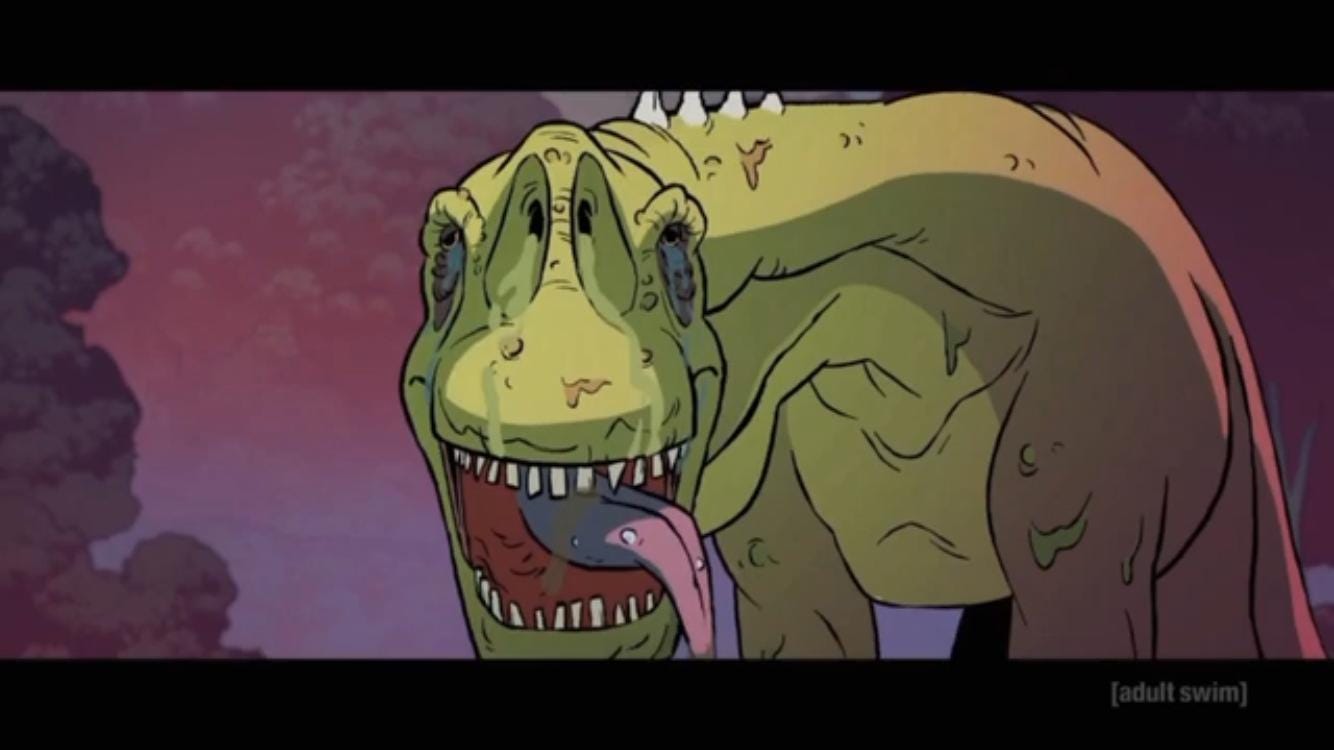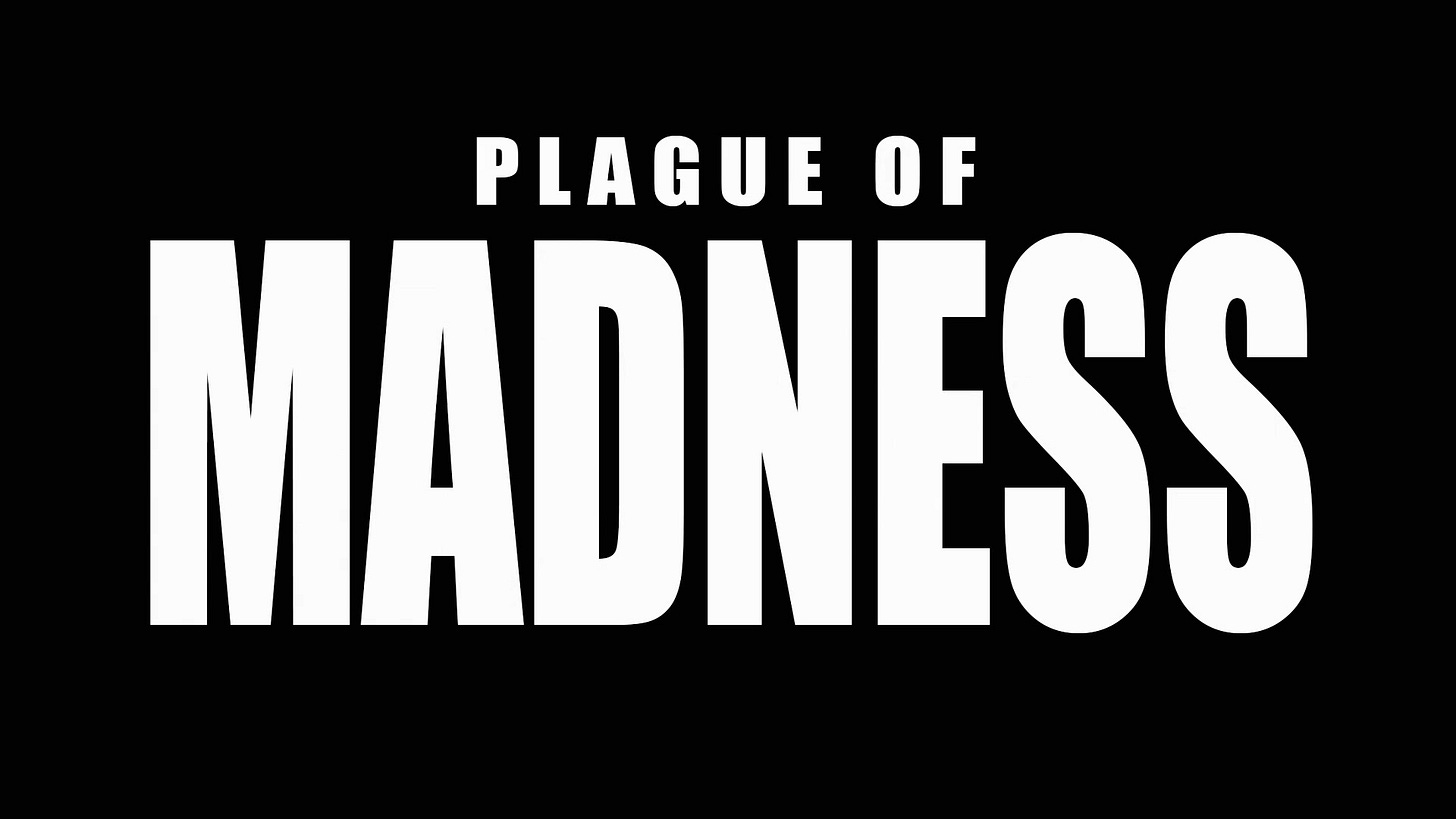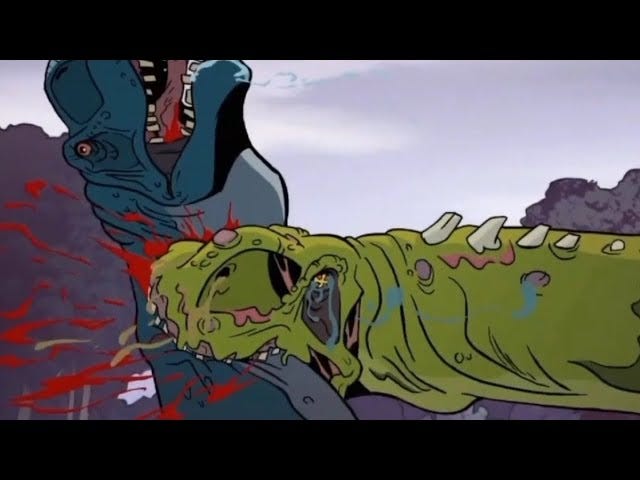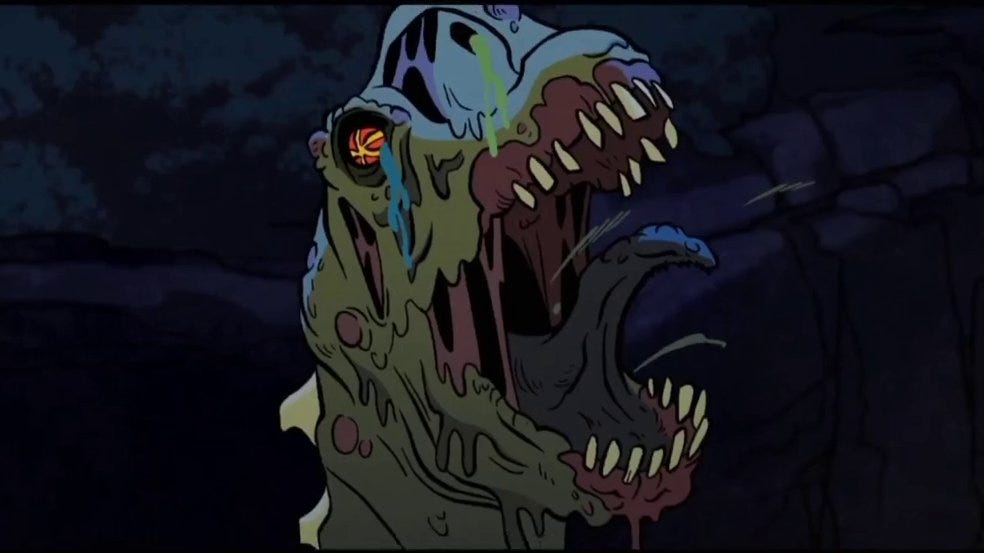Macabre Monday and the Plague of Madness
How a dialogue free cartoon about a caveman and a dinosaur created one of the most tense and harrowing horror experiences ever put to television.
A most morose Macabre Monday to you all, my magnificent misery mongers. I debated for quite a while whether or not to simply share this as a note or write a proper article. After getting started and realizing I had a decent amount to say on this subject, I opted for an article, as you can see. Funny enough, this is also the second Macabre Monday in a row where I come to you with a cartoon recommendation.
Last week I talked briefly about how well the Ed, Edd, n’ Eddy episode, “The Day the Ed Stood Still,” weaved the tropes of slasher, survival, and monster horror into a comedic homage to classic sci-fi/horror films. Today, I want to take a look at something distinctly more adult: Genndy Tartakovski’s Primal.
Some among you will read that name and immediately know who I’m talking about. For many of us, that man’s name represented a formative presence in our childhoods. For those unawares, Genndy Tartakovski is a highly regarded Russian-American animator and animation director, and chances are good that if your childhood spanned the 1990’s like mine did, you’ve seen his name and the shows he created. Even if you didn’t, chances are still good you may have seen some of his movies. And if you’re not sure, well, tell me if any of these names sound familiar:
The Powerpuff Girls
Samurai Jack
Hotel Transylvania
Dexter’s Lab
Symbionic Titan
Star Wars: Clone Wars Microseries
I’m sure at least one of those probably brought out some memories in most of you, and Primal is his most recent television animation project which aired on Cartoon Network’s “Adult Swim” nighttime animation block.

Those who are familiar with Primal are probably wondering why I’m talking about it here instead of Sword & Saturday, considering the entire show is itself primitive pulp fantasy with a little sword & sorcery thrown in. Well, that’s because I want to talk about the single episode that really put this show on the map. For those unaware, Primal started airing on October 8th, 2019, with the episode “Spear and Fang” introducing us to its two main characters - the caveman Spear, and his T-rex companion, Fang. The show follows a mostly episodic format through the first season. However, when the season’s final episode aired in November of 2020, strong hints were dropped that the second season would have more of an overarching plot.
The show was well received by critics and audiences alike throughout its first season, with many people citing episode 5, “Rage of the Ape-Men,” as the moment that cemented the series into epic status for them. I can’t hold them at fault for that opinion, either. Clips from “Rage of the Ape-Men” was one of the key reasons I started watching the show, and it was the first time since the opening episode that Tartakovsky really showcased the cold brutality of this primordial world he’s created.

Fans of the show largely found this episode to be brutally epic, so much so that it elevated the show from greatness to excellence in their eyes. The ripples it had in the fandom were pretty sizable and only fed further into the growing segment of the fanbase that liked to dig deep into the episodes for any extra details they may have missed. After all, in a show with no dialogue, the story must be told entirely through the visuals, the sound effects, and the music. Theory crafters found a fire lit inside their hearts as they studied the episodes and started piecing together hypotheses for how they interlinked, all in an effort to deepen the world and solve its mysteries.
However, for as well loved as it was by existing fans, “Rage of the Ape-Men” didn’t quite have the kind of impact needed to draw in new fans by the droves. It certainly had its pull, as mentioned it was clips from this exact episode that finally convinced me to watch the show, but the episode lacked the necessary element of reach to pull Primal out of its well-liked niche. It needed something more, some tie to the real world and our daily lives that would give it the little boost it needed to go viral. To be clear, yes, I did use that wording on purpose, and little did anyone know that touch of virality would come two episodes later with episode 7, the aptly titled “Plague of Madness.”
Officially released on October 11th, 2020, a year to the day after “Rage of the Ape-Men,” “Plague of Madness” ended up receiving something none of the other episodes would - an early preview release. Specifically, it got an early airing on April 1st, 2020, right at the height of COVID-19 lockdowns and hysteria. Now I’m not going to pretend to know for sure why Cartoon Network/Adult Swim released it when they did. I don’t know if Tartakovsky pushed for that or not as I haven’t looked into that, (nor do I plan to) but given the subject matter of the episode it’s a safe bet that then-current events were the reason.
And what an impact it had. Clips from the episode started to spread across the internet like wildfire, showcasing a debilitating zombie disease that turns a majestic and languid sauropod - one that quite intentionally has a look and expressiveness akin to Littlefoot’s Grandpa from Don Bluth’s The Land Before Time - into a raging, rampaging monstrosity hell bent on slaughtering every living thing in his path. Videos were released at the time touting the episode for the subtle warnings it gave to how we reacted to COVID and how quickly disease can spread, and while I don’t agree with the premise some seemed to hold that the episode was meant to serve this purpose - as the second episode produced since the mid-season break, “Plague of Madness” was likely finished well before COVID was even a known factor in the West - it’s pretty clear why this link was drawn and how this episode became such a sensation.
But perceived social commentary alone isn’t nearly enough for this episode to explode the way it did. There had to be something more to it, and there was. While many of the show’s episodes play with horror elements, none of them lean into them quite so much as this does, save perhaps the season’s penultimate episode, “The Night Feeder.” However, for as nerve wracking as that episode can be, it still doesn’t come close to matching the intensity that is “Plague of Madness.” But how does it achieve this? Let’s take a look.
As mentioned previously, Primal is a show with no dialogue, at least until the final episode of the first season. What little dialogue is there isn’t ever spoken in an understandable language and there are no subtitles, which ultimately leaves the show in the same place whether the characters are speaking or not. When you sit down to watch an episode, you’re in for a story that’s told visually, with everything you need expressed through the actions and expressions of the different characters. This proves to be a shockingly effective way of portraying emotion, as there’s no issues of clunky dialogue to get in the way of what’s going on. It also makes it a little easier to suspend disbelief when things get weird and crazy, as they often do in this show.
Where this episode specifically is concerned, its efficacy begins with what it chooses to show us. Most episodes of Primal have a sort of cold open, a calm before the storm that features Spear and Fang going about their business before the episode’s major threat shows up to throw a wrench in things. “Plague of Madness” changes this formula slightly. We still get the calm before the storm, but instead of opening on Spear and Fang, we open on the Camarasaurus (though some argue it’s an Argentinosaurus) pictured above, shortly before the infected Parasaurolophus bites his leg. The Parasaurolophus then dies soon after, succumbing to the wasting effects of the plague, and the sauropod starts making his way back home to his herd.
All it takes is a couple short cuts before we’re shown how rapidly this plague takes hold. Looking at the lighting and color palettes used in the scenery - like I said, this is the kind of show that invites deeper investigation - we can see that very little time has passed since the sauropod was bitten. Unfortunately, the rapid acting nature of this plague has him feeling very unwell.

Two things really stand out in this episode that help to make Primal as intense as it is. First and foremost is Tartakovsky’s art style. This is a man who’s shows many of us will have grown up watching. Dexter’s Lab, The Powerpuff Girls, and Samurai Jack - especially Samurai Jack - all had their fair share of action, but they were ultimately still shows for kids. Samurai Jack pushed the boundaries there, then broke them completely in its final season on Adult Swim, but for the most part it was an action cartoon specifically made to feed Tartakovsky’s love for action while also being family accessible. As such, his art style is something that’s nostalgic for many of us. We see his particular blend of blocky and sleek designs, the hyper-expressive nature of his art, and it all feels very cartoony. Yet, in Primal, that cartoony look wraps a show that is brutally violent. It creates for a shocking sense of dissonance because you wouldn’t expect visuals like what we get from a show that looks like this.
The other element that helps this episode is how it loosely grounds itself in reality. While the plague itself is far more virulent than any real world disease we’ve seen, the elements that comprise it are taken directly from shocking real world diseases that we recognize. The first and most obvious of these is wasting disease, which is highly infectious and can be seen in a number of animals, such as deer. This is one of those diseases that affects the brain and is caused by prions, folded over proteins that can cause other proteins to fold in the same way. The physical symptoms we see ravaging the sauropod’s body are an extreme variant of wasting disease.
The other half to this formula is a virus that isn’t considered a zombie disease in the way we usually think of them, like the infamous fungal strains that infect ants and force them to climb to the heights of trees so they can bloom and release their spores. However, given the severe behavioral changes it causes, rabies really could be seen in that way. Once the plague of madness fully takes hold of the sauropod, causing its eye to go yellow and bloodshot, then all the hallmarks of rabies we recognize come into play.
The sauropod goes on a vicious rampage through his herd, slaughtering every living thing he can find. If you’re moving when he happens to see you, you best believe he’s coming to stamp you into a puddle or rip you in half with his teeth. It’s shortly after this slaughter that Spear and Fang finally enter the story, as they come across the brutal aftermath, which I shan’t share images of here. Macabre Monday this may be, but trust me when I say that while it may look cartoonish, Primal isn’t a show for the faint of heart, especially this episode.
The rest of the episode is a flight for survival on the part of Spear and Fang as they’re relentlessly pursued by the mad sauropod, and it is easily one of the most consistently intense episodes not just of any animated show I’ve seen, but any show period. There is no respite for our heroes in this, and the relentless nature of this diseased creature is both horrifying and quite sad, as not only do we know that he’s acting like this completely outside of his own volition, but we see him continue to waste away further and further as the episode draws on.
Tartakovsky pulls no punches in this episode, and it’s not hard to see why it became such a viral phenomenon when it was released. I’d heard whispers about Primal well before this episode came out, but after my personal disappointment with the final season of Samurai Jack I gave it a pass at the time. It was only since the release of this episode that I found myself drawn to the series, right as season 2 was making its start. I watched clips, tried to learn a bit about what the show was, and eventually stumbled onto “Rage of the Ape-Men” as I mentioned earlier, and I was hooked. Yet for as bloody, brutal, and tragic as Primal can be, and for how often it plays with ideas of horror within its episodes, none of them are as intense or scary as “Plague of Madness,” where Genndy Tartakovsky plays his hand at horror to his absolute best.
Macabre Monday Crew:











Tartakovsky = Genius
I enjoyed Dexter's laboratory. Deedee was a blast to watch.
Samurai Jack was cool.
Powerpuff girls was okay.
i wish we had that animation style back. today's animation looks like trash.
I hadn't heard of primal. wonder where I can find it?
Haven't gotten around to seeing any primal but i love me some Genndy. He also did story boards for iron man 2 movie including the scene where iron man and war machine fight the horde of drones.